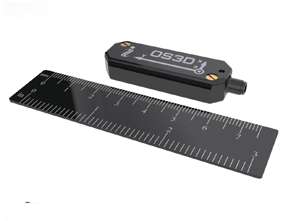Inertial Labs OS3D Tracker
Originally December 2014
Updated Dec. 2016
I’ve been using the Inertial Labs OS3D sensor as a head tracker over the last month or so. This thing rocks!! I’ve also used some of the other Inertial Labs sensors such as the OS3DM and the OS3D-FG. Here we’ll focus on the OS3D base model, which I have the most experience with.

I’m using it in a WorldViz Vizard demo application and after going through several other trackers including HillCrest FSM-9, YEI 3-Space, Intersense InertiaCube2, and several DIY trackers, the OS3D tracker provided the highest update rates and smoothest performance of any 3DOF tracker I’ve used so far. I needed to provide a flawless head tracking experience for a group that would be highly critical. Needless to say, this year I didn’t receive one negative comment about tracker performance. Interial Labs was actually coming over to our booth because the tracker performance was so good! I also let anyone who asked know it was an Inertial Labs sensor.
The OS3D is a ~$1k tracker that claims 1 degree heading accuracy (RMS), and 0.2 degree pitch and roll accuracy (RMS). It’s package size of 50.7mm x 14.5mm x 9.2mm provides a nice small package to mount to a HMD head mount. It looks professional too in an aluminum casing with a single wire down to the computer. At the PC end there’s a small USB dongle which appears to house the processor. I used their inertiallabs_sdk_lite.dll within Vizard along with the associate ini file. There are a ton of options to tweak within the ini file. The most important to me were the update frequency, which can be set to 500Hz, and the KpINI value. See my values below for an awesome Vizard head tracking setup. You’ll want to read the SDK manual to learn what all the options are doing.
This tracker is probably out of reach of most homebrewers or gamers but if you can get a hold of one, it’s definitely worth every penny. I’ve used just about every low dollar tracker there is and the OS3D is definitely a class above. It’s my favorite so far of the high end sensors. It seemed to perform better than my InertiaCube2 sensors as well. Inertial Labs even has a way of making the OS3D look like an Intersense tracker so you can use any applications that already support Intersense.
Check out more information on the Inertial Labs OS3D sensor on the Inertial Labs webpage.
Here’s my inertiallabs_sdk_lite.ini file contents. I did some tweaking of the values to get things just right in my Vizard demo.
[WorksetNode_0]
COM=33
BaudRate=1000000
WCUChannel = 0
;SensorsData = Sensors19-20.dat
;IP = 127.0.0.1
KpINI = 0.01
ThreshMagINI = 0.015
MagErrorComp = 0.01
DelayOnMagDisturbINI = 0
KprMagINI = 0.05
ThreshGyroINI = 20
KprMagMaxINI = 0.99
Frequency = 500
TimeStartSec = 2
GyroZeroAveragingTimeSec = 1
QuatFilterKoef = 1
PredictionTime = 16
is_mag_chennel = 1
is_mag_new_norm_calc = 0
smoothing_mode = 1
 Mellott's VR
Mellott's VR